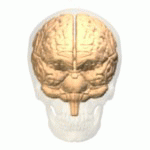If someone takes something of yours from your locker, does it matter if they intended to steal, or if they grabbed it by mistake because they thought it was their locker? We see there is a moral difference here, because people’s intentions and beliefs matter. An inadvertent mistake is one thing, but intentionally stealing is another.
We can see the difference, but typically, children under six do not. They see both things as just as bad, because they do not consider intentions.

A recent study (Young et al., 2010) found the part of the brain that seems to be responsible for the consideration of intentions in moral judgment. This part of the brain, the right temporoparietal junction, develops between the ages of six and eleven.
I find this work fascinating because it implies that adolescents may still be developing the ability for deeper moral judgment when they get to middle school. It would help explain why they will sometimes make the argument that if the outcome did no harm then any transgression does not matter; taking something from someone’s locker is not that important if they get caught at it and have to return it.
Just like adolescents have to exercise our abstract thinking skills in order to fully develop and hone them, students probably need to practice and think about what morality means.
I think I’m going to have to figure out a framework for talking about morality for next cycle’s Personal World.
Note: Another interesting article on the role of the temporoparietal junction in meta-cognition.